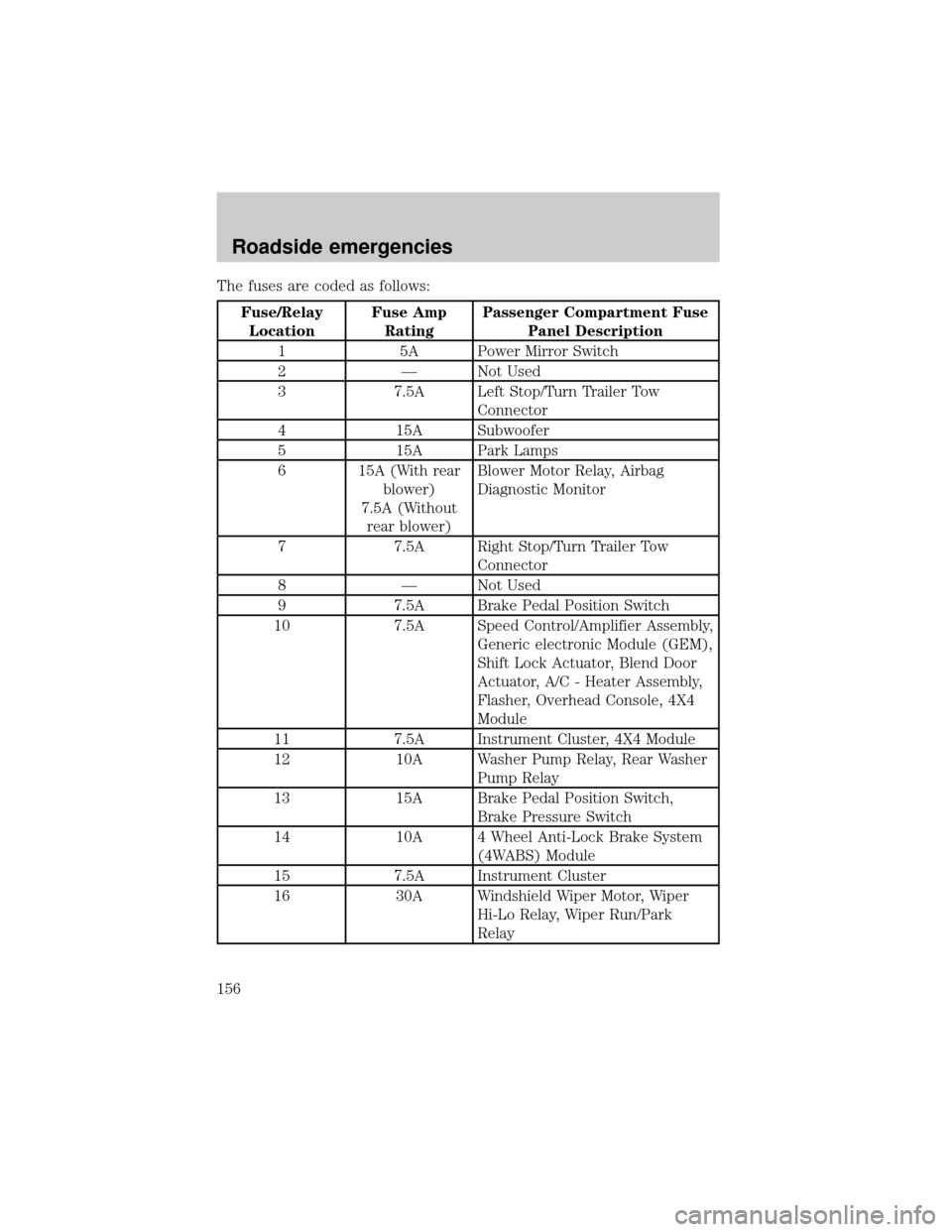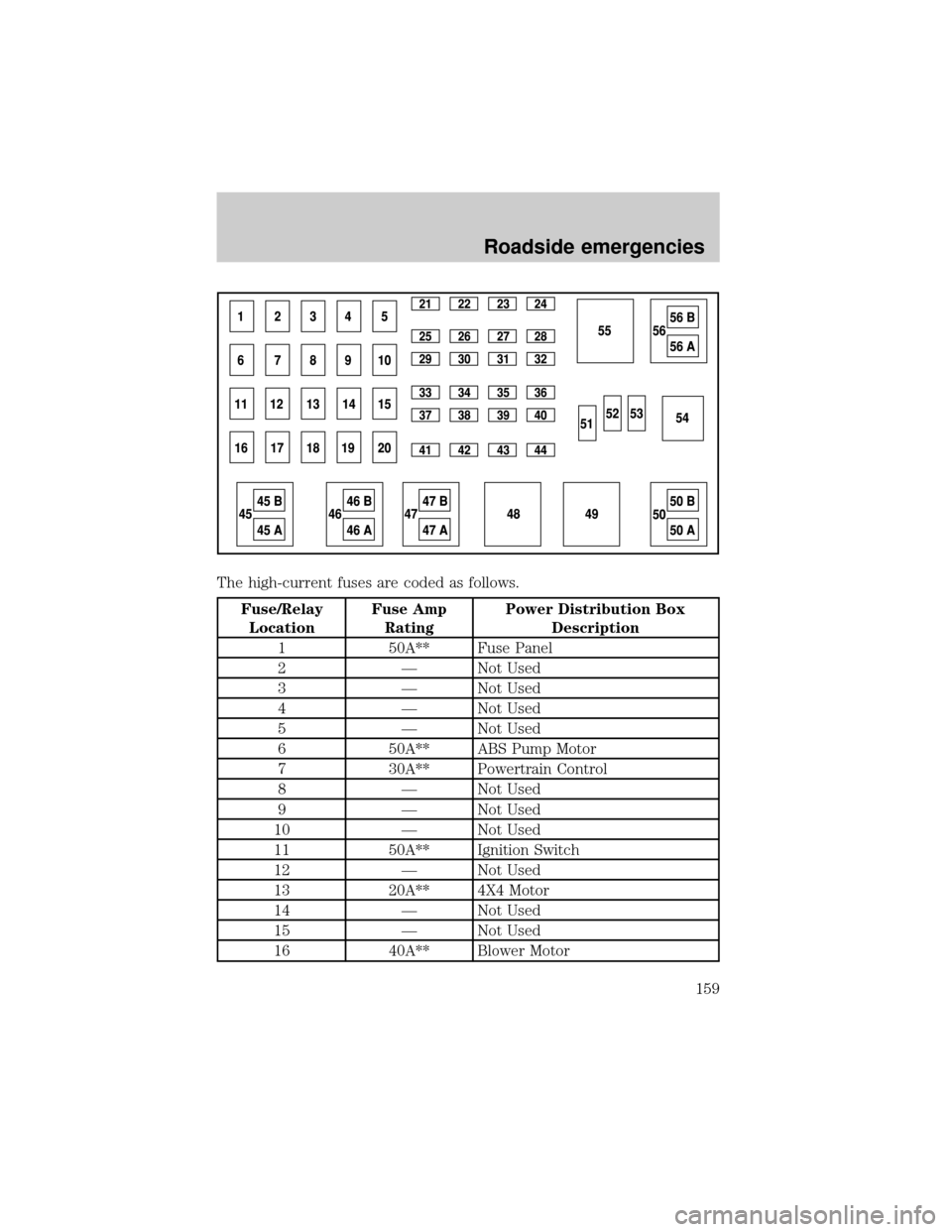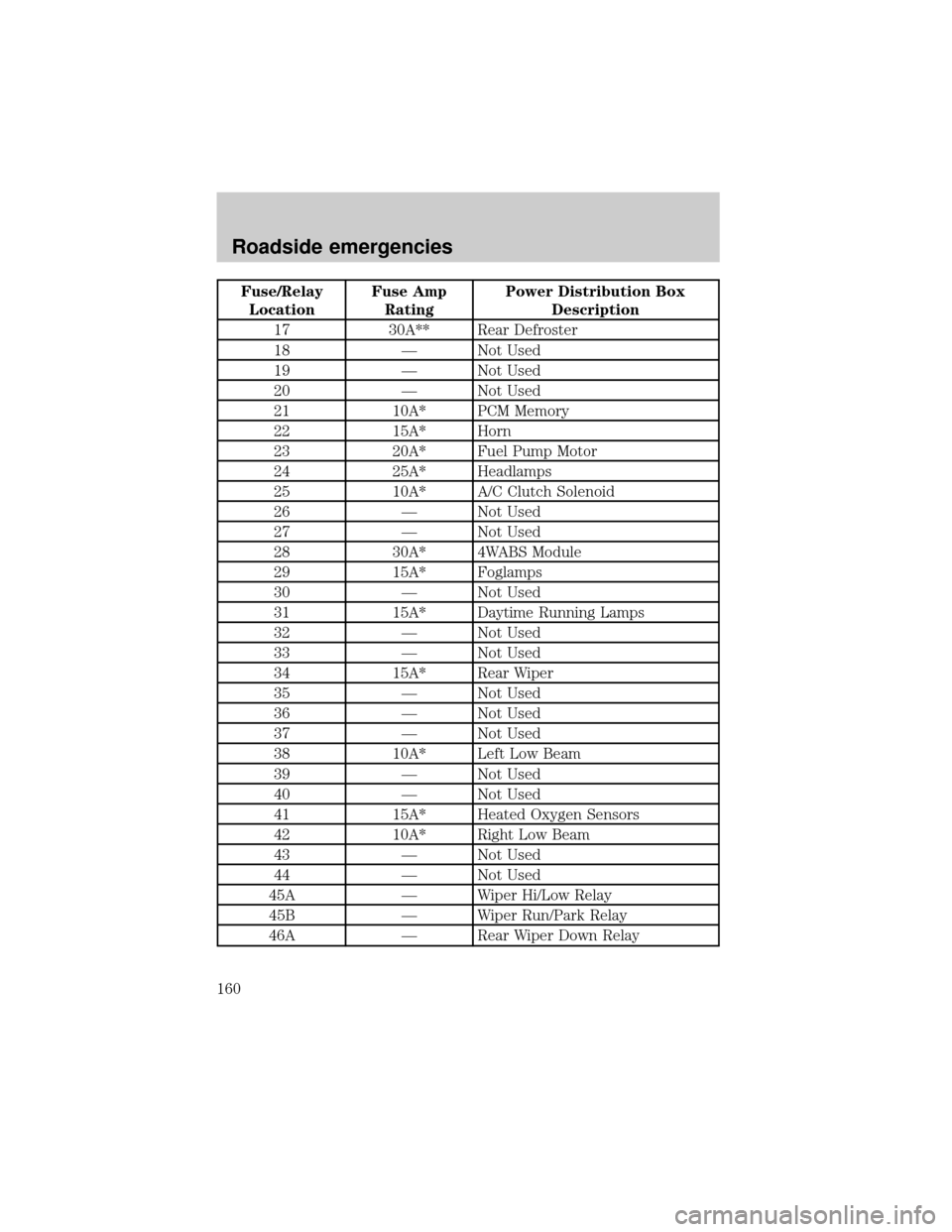2001 FORD EXPLORER SPORT ABS
[x] Cancel search: ABSPage 156 of 256

The fuses are coded as follows:
Fuse/Relay
LocationFuse Amp
RatingPassenger Compartment Fuse
Panel Description
1 5A Power Mirror Switch
2 Ð Not Used
3 7.5A Left Stop/Turn Trailer Tow
Connector
4 15A Subwoofer
5 15A Park Lamps
6 15A (With rear
blower)
7.5A (Without
rear blower)Blower Motor Relay, Airbag
Diagnostic Monitor
7 7.5A Right Stop/Turn Trailer Tow
Connector
8 Ð Not Used
9 7.5A Brake Pedal Position Switch
10 7.5A Speed Control/Amplifier Assembly,
Generic electronic Module (GEM),
Shift Lock Actuator, Blend Door
Actuator, A/C - Heater Assembly,
Flasher, Overhead Console, 4X4
Module
11 7.5A Instrument Cluster, 4X4 Module
12 10A Washer Pump Relay, Rear Washer
Pump Relay
13 15A Brake Pedal Position Switch,
Brake Pressure Switch
14 10A 4 Wheel Anti-Lock Brake System
(4WABS) Module
15 7.5A Instrument Cluster
16 30A Windshield Wiper Motor, Wiper
Hi-Lo Relay, Wiper Run/Park
Relay
Roadside emergencies
156
Page 159 of 256

The high-current fuses are coded as follows.
Fuse/Relay
LocationFuse Amp
RatingPower Distribution Box
Description
1 50A** Fuse Panel
2 Ð Not Used
3 Ð Not Used
4 Ð Not Used
5 Ð Not Used
6 50A** ABS Pump Motor
7 30A** Powertrain Control
8 Ð Not Used
9 Ð Not Used
10 Ð Not Used
11 50A** Ignition Switch
12 Ð Not Used
13 20A** 4X4 Motor
14 Ð Not Used
15 Ð Not Used
16 40A** Blower Motor
Roadside emergencies
159
Page 160 of 256

Fuse/Relay
LocationFuse Amp
RatingPower Distribution Box
Description
17 30A** Rear Defroster
18 Ð Not Used
19 Ð Not Used
20 Ð Not Used
21 10A* PCM Memory
22 15A* Horn
23 20A* Fuel Pump Motor
24 25A* Headlamps
25 10A* A/C Clutch Solenoid
26 Ð Not Used
27 Ð Not Used
28 30A* 4WABS Module
29 15A* Foglamps
30 Ð Not Used
31 15A* Daytime Running Lamps
32 Ð Not Used
33 Ð Not Used
34 15A* Rear Wiper
35 Ð Not Used
36 Ð Not Used
37 Ð Not Used
38 10A* Left Low Beam
39 Ð Not Used
40 Ð Not Used
41 15A* Heated Oxygen Sensors
42 10A* Right Low Beam
43 Ð Not Used
44 Ð Not Used
45A Ð Wiper Hi/Low Relay
45B Ð Wiper Run/Park Relay
46A Ð Rear Wiper Down Relay
Roadside emergencies
160
Page 201 of 256

²Extinguish all smoking materials
and any open flames before
fueling your vehicle.
²Always turn off the vehicle before
fueling.
²Automotive fuels can be harmful
or fatal if swallowed. Fuels such
as gasoline and ethanol are highly
toxic and if swallowed can cause
death or permanent injury. If fuel
is swallowed, call a physician immediately, even if no symptoms are
immediately apparent. The toxic effects of fuel may not be visible for
hours.
²Avoid inhaling fuel vapors. Inhaling too much fuel vapor of any kind
can lead to eye and respiratory tract irritation. In severe cases,
excessive or prolonged breathing of fuel vapor can cause serious
illness and permanent injury.
²Avoid getting fuel liquid in your eyes. If fuel is splashed in the eyes,
remove contact lenses (if worn), flush with water for 15 minutes and
seek medical attention. Failure to seek proper medical attention could
lead to permanent injury.
²Fuels can also be harmful if absorbed through the skin. If fuel is
splashed on the skin and/or clothing, promptly remove contaminated
clothing and wash skin thoroughly with soap and water. Repeated or
prolonged skin contact with fuel liquid or vapor causes skin irritation.
²Be particularly careful if you are taking ªAntabuseº or other forms of
disulfiram for the treatment of alcoholism. Breathing gasoline and/or
ethanol vapors, or skin contact could cause an adverse reaction. In
sensitive individuals, serious personal injury or sickness may result. If
fuel is splashed on the skin, promptly wash skin thoroughly with soap
and water. Consult a physician immediately if you experience an
adverse reaction.
²FFV fuel tanks may contain zero to 85 percent ethanol. Any fuel
blends containing gasoline and ethanol should be treated the same as
ªFuel Ethanol (E85)º. To identify if your vehicle is an FFV, check your
VIN or the label on the inside of your fuel filler door. When checking
the VIN look for the engine type identifier (8th character). If your
vheicle is an FFV, then the character will be labeled as a ªK.º
Maintenance and care
201
Page 206 of 256

4. To install the cap, align the tabs on the cap with the notches on the
filler pipe.
5. Turn the filler cap clockwise 1/8 of a turn until it stops.
If the ªCheck Fuel Capº indicator comes on and stays on after you start
the engine, the fuel filler cap may not be properly installed. Turn off the
engine, remove the fuel filler cap, align the cap properly and reinstall it.
If you must replace the fuel filler cap, replace it with a fuel filler
cap that is designed for your vehicle. The customer warranty may
be void for any damage to the fuel tank or fuel system if the
correct genuine Ford or Motorcraft fuel filler cap is not used.
The fuel system may be under pressure. If the fuel filler cap is
venting vapor or if you hear a hissing sound, wait until it stops
before completely removing the fuel filler cap. Otherwise, fuel may
spray out and injure you or others.
If you do not use the proper fuel filler cap, excessive pressure or
vacuum in the fuel tank may damage the fuel system or cause
the fuel cap to disengage in a collision, which may result in possible
personal injury.
Fuel Filter
For fuel filter replacement, see your dealer or a qualified service
technician. Refer to the scheduled maintenance guide for the appropriate
intervals for changing the fuel filter.
Replace the fuel filter with an authorized Motorcraft part. The
customer warranty may be void for any damage to the fuel system
if an authorized Motorcraft fuel filter is not used.
ESSENTIALS OF GOOD FUEL ECONOMY
Measuring techniques
Your best source of information about actual fuel economy is you, the
driver. You must gather information as accurately and consistently as
possible. Fuel expense, frequency of fillups or fuel gauge readings are
NOT accurate as a measure of fuel economy. We do not recommend
taking fuel economy measurements during the first 1 600 km (1 000
miles) of driving (engine break-in period). You will get a more accurate
measurement after 3 000 km±5 000 km (2 000 miles-3 000 miles).
Maintenance and care
206
Page 213 of 256

5. Without turning, remove the old
bulb from the lamp assembly by
gently pulling it straight back out of
the lamp assembly.
To install the new bulb:
Handle a halogen headlamp bulb carefully and keep out of
children's reach. Grasp the bulb only by its plastic base and do
not touch the glass. The oil from your hand could cause the bulb to
break the next time the headlamps are operated.
1. With the flat side of the new bulb's plastic base facing upward, insert
the glass end of the bulb into the lamp assembly. Turn the bulb left or
right to align the grooves in the plastic base with the tabs in the lamp
assembly. When the grooves are aligned, push the bulb into the lamp
assembly until the plastic base contacts the rear of the lamp assembly.
2. Install the bulb retaining ring over the plastic base until it contacts the
rear of the socket by rotating it clockwise until you feel a ªstop.º
3. Connect the electrical connector into the rear of the plastic base until
it snaps, locking it into position.
4. Install the headlamp on vehicle by aligning the lamp on the vehicle,
push rearward and secure with two retainer pins.
5. Install the protective cover over headlamps locking it in place.
6. Turn the headlamps on and make sure they work properly. If the
headlamp was correctly aligned before you changed the bulb, you should
not need to align it again.
Maintenance and care
213
Page 245 of 256

A
Air bag supplemental restraint
system ................................103, 109
and child safety seats ............105
description ......................103, 109
disposal ....................................112
driver air bag ..................106, 110
indicator light ...........12, 108, 111
operation .........................106, 110
passenger air bag ...........106, 110
side air bag ..............................109
Air cleaner filter ...............182, 224
Air conditioning ..........................22
rear seat controls .....................25
Ambulance packages ....................4
Antifreeze (see Engine
coolant) .....................................183
Anti-lock brake system (see
Brakes) ..............................125±126
Anti-theft system
warning light .............................13
Audio system (see Radio) .........28
Automatic transmission ............129
driving an automatic
overdrive .................................130
fluid, adding ............................188
fluid, checking ........................188
fluid, refill capacities ..............224
fluid, specification ..................228
Auxiliary power point .................72
Axle
lubricant specifications ..226, 228
refill capacities ........................224
traction lok ..............................128B
Battery .......................................192
acid, treating emergencies .....192
charging system warning
light ............................................13
jumping a disabled battery ....166
maintenance-free ....................192
replacement, specifications ...224
servicing ..................................192
voltage gauge ............................18
Belt minder .................................99
Brakes ........................................125
anti-lock ...........................125±126
anti-lock brake system (ABS)
warning light .....................12, 126
brake warning light ..................12
fluid, checking and adding ....180
fluid, refill capacities ..............224
fluid, specifications .........226, 228
lubricant specifications ..226, 228
parking ....................................126
shift interlock ..........................129
Break-in period .............................3
C
Capacities for refilling fluids ....224
Cargo area shade ........................74
Cargo cover .................................74
Cassette tape player ...................37
Certification Label ....................231
Child safety restraints ..............112
child safety belts ....................112
Child safety seats ......................113
attaching with tether straps ..117
in front seat ............................115
in rear seat ..............................115
Index
245
Page 248 of 256

GVWR (Gross Vehicle Weight
Rating) .......................................141
calculating .......................141, 143
definition .................................141
driving with a heavy load ......141
location ....................................141
H
Hazard flashers .........................152
Head restraints .....................87, 91
Headlamps ...................................20
aiming ..............................216±217
bulb specifications ..................216
daytime running lights .............20
flash to pass ..............................21
high beam ...........................13, 21
replacing bulbs .......................212
turning on and off ....................20
warning chime ..........................15
Heating ........................................22
heating and air conditioning
system .......................................22
Hood ..........................................175
I
Ignition .........................56, 228±229
Infant seats (see Safety seats) 113
Inspection/maintenance (I/M)
testing ........................................211
Instrument panel
cleaning ...................................221
cluster ................................10, 222
lighting up panel and
interior .......................................21
location of components ............10J
Jack ............................................161
positioning ...............................161
storage .....................................161
Jump-starting your vehicle ......166
K
Keyless entry system .................79
autolock .....................................82
keypad .......................................79
locking and unlocking doors ....81
programming entry code .........80
Keys .......................................83±85
key in ignition chime ...............15
positions of the ignition ...........56
L
Lamps
bulb replacement
specifications chart ................216
cargo lamps ...............................21
daytime running light ...............20
fog lamps ...................................20
headlamps .................................20
headlamps, flash to pass ..........21
instrument panel, dimming .....21
interior lamps ...................68, 216
replacing bulbs ..............211±212,
214±215
Lane change indicator (see
Turn signal) .................................56
Liftgate ........................................73
Lights, warning and indicator ....10
air bag ........................................12
anti-lock brakes (ABS) ....12, 126
anti-theft ...................................13
brake ..........................................12
Index
248